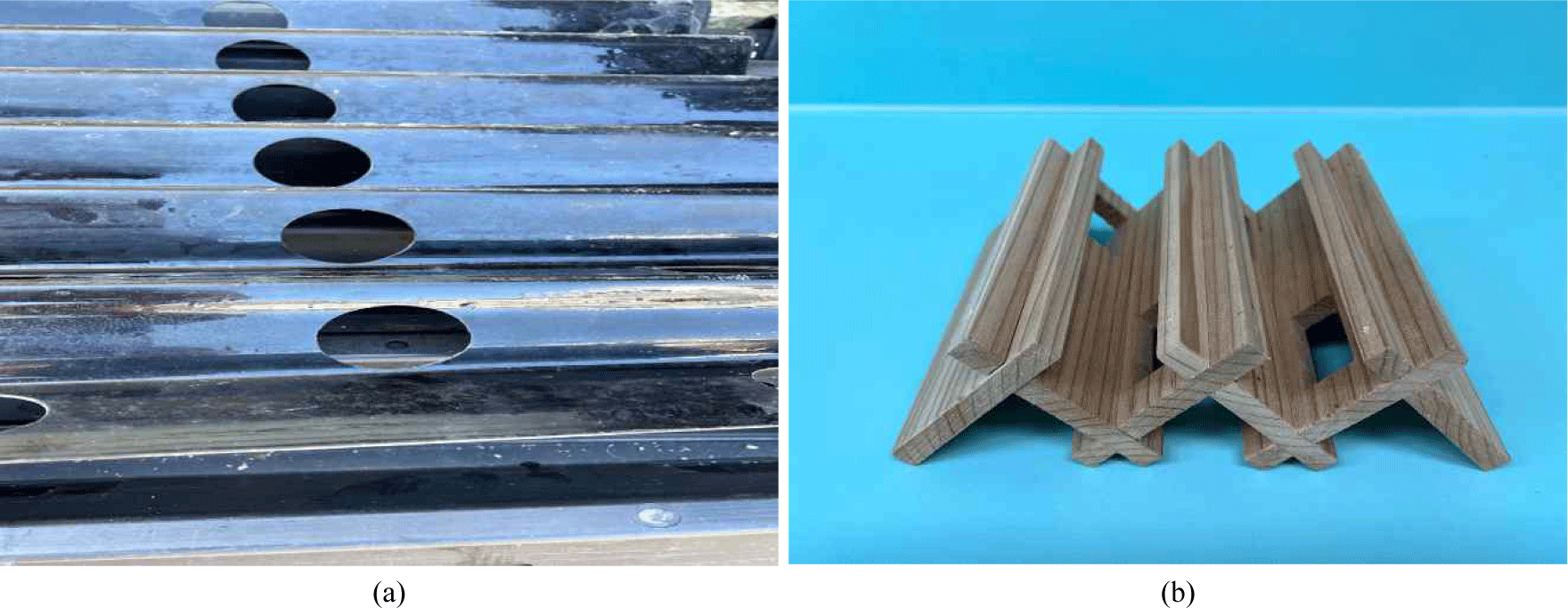1. INTRODUCTION
Microplastics (MPs) are defined as plastic particles ranging in size from 1 μm to 5 nm (Thompson et al., 2004). MPs are ubiquitous in marine, terrestrial and atmospheric systems (Veerasingam et al., 2022). There is a growing concern on MPs due to their potential negative impacts on ecosystems and human health (Lee et al., 2022). In particular, MPs in the marine ecosystem can accumulate in planktonic and invertebrate aquatic creatures, which then get transmitted into the food chain, and could potentially be hazardous to humans (Rani et al., 2023). Therefore, various methods, such as biodegradation, incineration, landfilling and recycling, have been applied to remove MPs (Anand et al., 2023; Bacha et al., 2023; Prata et al., 2020).
In South Korea, seaweed is the most important item of aquaculture products, followed by mollusks, fin fish and crustacean (Food and Agriculture Organization [FAO], 2020). Plastic equipment such as fishing nets, foam buoys, and shelters have been widely used in aquaculture. However, the equipment decomposes gradually through the physical, photochemical and biological degradation processes, releasing large amounts of MPs into the marine environment (Yao et al., 2021). Additionally, aquaculture activities can lead to a higher abundance of MPs in the aquaculture areas than that in the open ocean (Chen et al., 2018). Consequently, aquatic organisms are susceptible to accidental ingestion of MPs, for reasons including, but not limited to, their color being similar to their normal prey or MPs being mixed with their food sources (Zhang et al., 2021). The abundance of MPs in a specific habitat can also significantly affect the accumulation of MPs in aquaculture products.
South Korea has become an important producer of farmed abalone over the past decade. The production has increased from an estimated 1,000 metric tonnes (MT) in 2003 to over 20,000 MT in 2021 (Cook, 2023). Abalones were produced in 2,549 abalone farms with 3,095 hectares using a cage-cultivating method in 2020 (Sim et al., 2021). In abalone aquaculture, several types of equipment, such as sequential enclosure, various kinds of shelter, pipes for frames and boundary buoys, have been used (Gwang Myeong Bio Industry [GBI], 2020). The equipment is made of polypropylene (PP), polyvinylchloride, polyethylene terephthalate (PET) and even recycled plastics. There have been cases of harmful substances and chemical toxins found in the plastic-based equipment. In addition, plastic-based shelters are used for farmed abalones to provide a habitat that blocks direct sunlight and these shelters tend to be more susceptible to abalones ingesting plastics, resulting in them being a vector for transfer of MPs into the human food chain (Li et al., 2018). As a result, finding a raw material for producing environmentally friendly shelters is required to provide an alternative to PP shelters. However, there has been a lack of research and investigation into these concerns.
A variety of raw materials including but not limited to stainless steel, glass, natural fiber, bamboo, ceramics, paper and cardboard can be used as an alternative to plastic-based equipment in aquaculture. Among the raw materials, wood can be a very suitable candidate due to its availability and workability, which can result in it being relatively cost-effective. However, wood in marine application is exposed to conditions that can cause severe degradation, such as the recurrent impact of shingles, sand, ice, and other solid fragments transported by waves, wind and tides (Oevering et al., 2001; Song et al., 2024). In addition, wood-deteriorating organisms such as bacteria, decay fungi and marine borers can accelerate degradation (Nandika et al., 2023; Treu et al., 2019; Xu et al., 2021). Therefore, a unique treatment process for woods is required to make it sustainable for use in harsh marine environments. Hydrogenated castor oil (HCO) can be used as a treating agent for wooden materials because castor oil, a precursor of HCO, has fungicidal and insecticidal properties. More importantly, HCO of its semi-solid form (wax-like) is insoluble in both water and organic solvents at ambient temperature (Ahmed et al., 2014; Chauke et al., 2019; Kodjo et al., 2011). HCO begins to liquify at temperature of 80°C and above, and liquefied HCO has been extensively applied for various industrial uses. Aside from its applicability, HCO has a longer shelf life, enhanced thermal and oxidative stability, and is odorless and tasteless (Mubofu, 2016). Owing to these properties, HCO and its derivatives have been used for applications in paints, cosmetics, coatings and lubricants industries (Ahmed et al., 2014; Yousef et al., 2001). However, no studies have investigated the potential of HCO as a treating agent for wood in marine applications.
Therefore, the leaching resistance and dimensional stability of various wood species treated with HCO using a pressure treatment in saline water were evaluated to investigate the potential of HCO-impregnated wood for marine applications. In addition, the level of MPs generated from wooden and plastic shelters immersed in saline water was compared to identify the potential of wood as an environmentally friendly raw material for the production of shelters. The on-site application of wooden shelters is expected to mitigate MP-related pollution in areas of abalone aquaculture.
2. MATERIALS and METHODS
Japanese cedar (Cryptomeria japonica D., JAC), soft maple (Acer saccharinum, MAP), Mongolian oak (Quercus mongolica, OAK) and western hemlock (Tsuga heterophylla, HEM) without distinction between sapwood or heartwood were used as raw materials in this study. These wood species were specifically used as they play an essential role in the wood industry of South Korea. For example, JAC is the most widely distributed softwood in the southern region of South Korea and has been used to produce furniture, boxes, veneers and plywood (Hong et al., 2015). HEM and MAP are the most imported softwood and hardwood species, respectively (Korea Forest Service [KFS], 2023). HEM is commonly used for plywood, crates, framing, siding and other construction purposes. MAP has been used as fancy veneer for the production of floors, kitchen cabinets, joinery and furniture. OAK is the most widely distributed hardwood in South Korea and has been used in furniture and finishing lumber (Lee et al., 2022).
HCO in the shape of flakes was purchased from the Hebei Guanlang Biotechnology (Shijiazhuang, China). The HCO was used as a treating agent for wood specimens. Physical and chemical properties of the HCO is presented in Table 1 (Ahmed et al., 2014; Alwaseem et al., 2014; Chauke et al., 2019; Kodjo et al., 2011; Yousef et al., 2001).
Twelve wood blocks (2.54 cm × 2.54 cm × 2.54 cm) and strips (7.00 cm × 2.54 cm × 0.70 cm, L × W × T) of each species, assigned randomly, were stacked with 4 and 2 specimens per layer in a 2-liter beaker, respectively. A Teflon® mesh screen was placed on each layer to minimize experimental deviations resulting from the contact between specimens. A ceramic-based mortar was placed on the top layer to prevent wood blocks from floating. The HCO, liquefied in an oven at 105 ± 2.5°C overnight, was poured into the beaker until the wood specimens were sufficiently submerged in HCO. The specimens immersed in liquefied-HCO were treated under a vacuum of 750 mm Hg in a vacuum oven (DH SWOV03030, Daihan Scientific, Wonju, Korea) at 105°C for 15 or 30 min. Subsequently, the beaker was transferred to a laboratory pressure cylinder made specifically for this study, and then treated with 40 kgf/cm2 pressure at 90°C for 15 or 30 min (Fig. 1). Right after the treatment, extra HCO present on the surface of each specimen was removed using a paper towel. Then, the cleansed specimens were conditioned at 25°C for at least 24 hours to obtain the actual HCO retention in each wood specimen. The amount of HCO taken up by the specimens was measured by comparing their original dry weight to their final dry weight after treatment. The HCO uptake was calculated as follows:
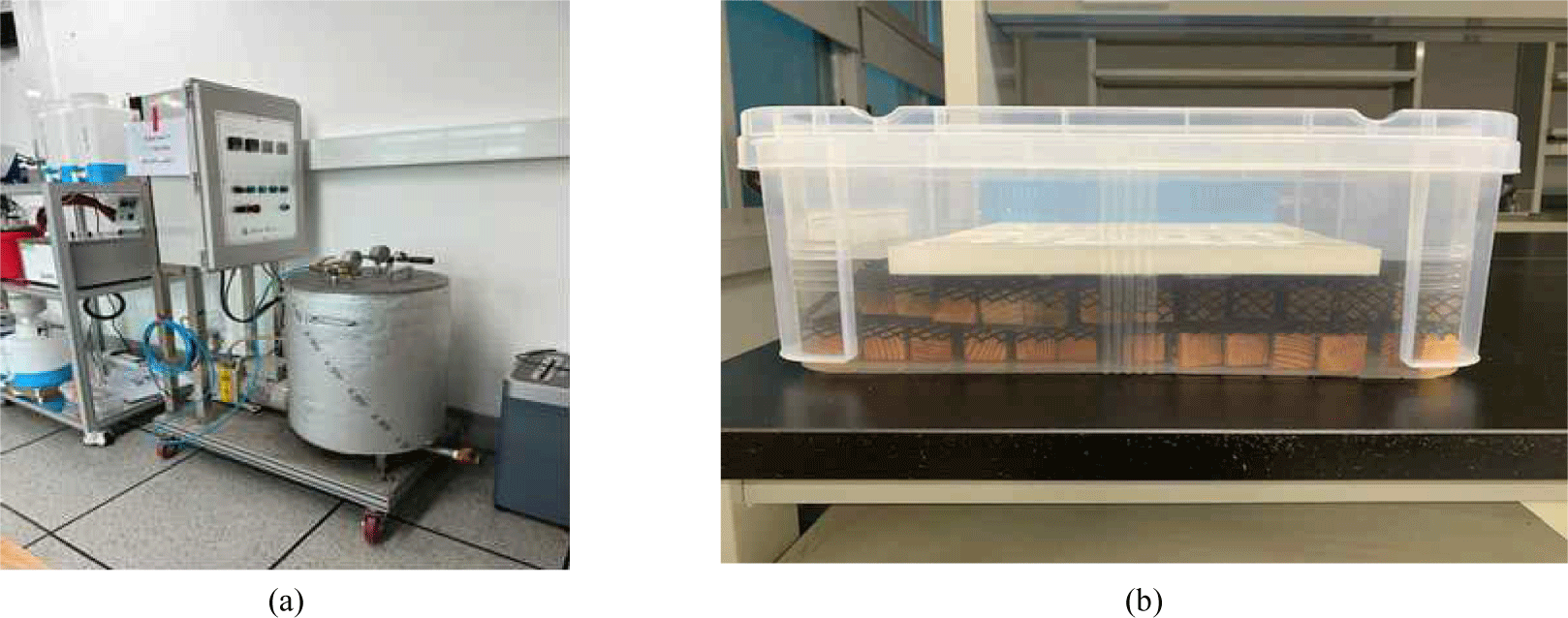
Where W0 and W1 are the weight of dried wood specimens before and after HCO treatment, respectively.
Twelve HCO-treated wood blocks and strips were subjected to saline water leaching (35 parts of solar salt in 1 liter of deionized water) in a 20-liter plastic box for 48 hours and 2 weeks, respectively, to evaluate the leaching resistance and dimensional stability of the specimens (Fig 1). The immersed wood specimens were washed at least 5 times with tap water and subsequently air-dried for one week. The air-dried specimens were placed in an oven at 50°C for one week. The weight and dimensions (length, width, thickness) of the wood specimens were measured before and after the leaching procedure. Leachability of the wood specimens was calculated using the formula below:
Where W1 is the dried weight of wood specimen treated with HCO (g); and W2 is the dried weight of wood specimen leached in saline water for 48 hours (g).
For measuring dimensional stability, HCO-treated wood strips, which underwent a 30-min vacuum and 30-min pressure treatments (HCO-1), were selected according to the leachability results of HCO-treated wood blocks. Dimensional stability of the wood strips was calculated based on the total volumetric swelling (TVS) using the formula below.
Where D1 = volume of the air- and oven-dried wood strips treated with HCO (mm); and D2 = volume of the air- and oven-dried wood strips treated with HCO and then leached in saline water for two weeks (mm).
The retention of HCO in the strips after leaching was investigated by observing the strips leached in saline water for 2 weeks with an X-ray microscope (Xradia 620, Zeiss, Oberkochen, Germany). The strips were mounted vertically in custom-made partitions using tall aluminum holders and were rotated horizontally by 360° on the stage. Scanning of the specimens was performed at 85–95 μm resolution using a flat panel detector with energy settings of 60 kV, 111 μA and a power source of 6.5 W with an air filter and 801 projections. Structural images of the strips were presented using the Dragonfly Pro software (Object Research Systems, Montréal, QC, Canada).
HCO-1-treated wood strips were exposed outdoors for two weeks (from June 27, 2022 to July 11, 2022). The exposure period was a rainy season and thus showed high temperature (24°C–30°C) and humidity (75%–95%). Moisture absorption (MA) and TVS of the outdoor-exposed wood strips were measured to investigate the effect of HCO treatment on hydrophobicity of wood strips as moisture uptake has negative effects on most physical properties of wood-based products. The MA and TVS values were calculated as the weight and dimensional differences of the strips before and after outdoor exposure.
HCO-1-treated wood strips used for determining leachability and dimensional stability were also used for measuring bending strength and Janka hardness. The bending strength and Janka hardness tests were conducted in accordance with the American Society for Testing and Materials (ASTM) D 4761-19 and ASTM D 143, respectively (ASTM, 2009, 2019; Kwon et al., 2023a, 2023b; Oh, 2022).
JAC was selected as a wood species for fabricating a small-size wooden shelter based on the results of its HCO uptake, leachability, dimensional stability and physical strengths of wood specimens. Availability, economic feasibility and workability were also considered in the selection. JAC planks with dimensions of 50 cm × 8 cm × 1 cm were cut into pieces with a calculated dimension according to the design plan. The pieces were treated with the liquefied HCO in a vessel by the 15-min vacuum (750 mm Hg) and then subsequently 15-min pressure (40 kgf/cm2) treatments. After that, the pieces were conditioned at 25°C for 24 hours. As shown in Fig. 2, the HCO-treated pieces were assembled as a shelter for abalone aquaculture.
Two specimens from each plastic and wooden shelter with the same surface area (1,274 cm2) were placed on the bottom of glass aquariums with dimensions of 45 cm × 45 cm × 45 cm (Aquagarden, Yangju, Korea) as shown in Fig. 3. The plastic shelters used in this study, produced from PP by the GBI (Gwangju, Korea), are commonly used for abalone aquaculture. Then a ceramic-based mortar was placed on the shelters to prevent them from floating. Saline water of 32 L (35 grams of solar salt in each liter of tap water) was poured into the aquarium and then circulated with the operation of a chemical filtration system, which involves the absorption of chemicals from the water by using activated carbon as an absorptive medium. Saline water samples of 1.2 L collected from each aquarium were transferred to two 1 L pre-cleansed, amber glass bottle in 600 mL increments. Saline water sample collection was conducted every two to six weeks.
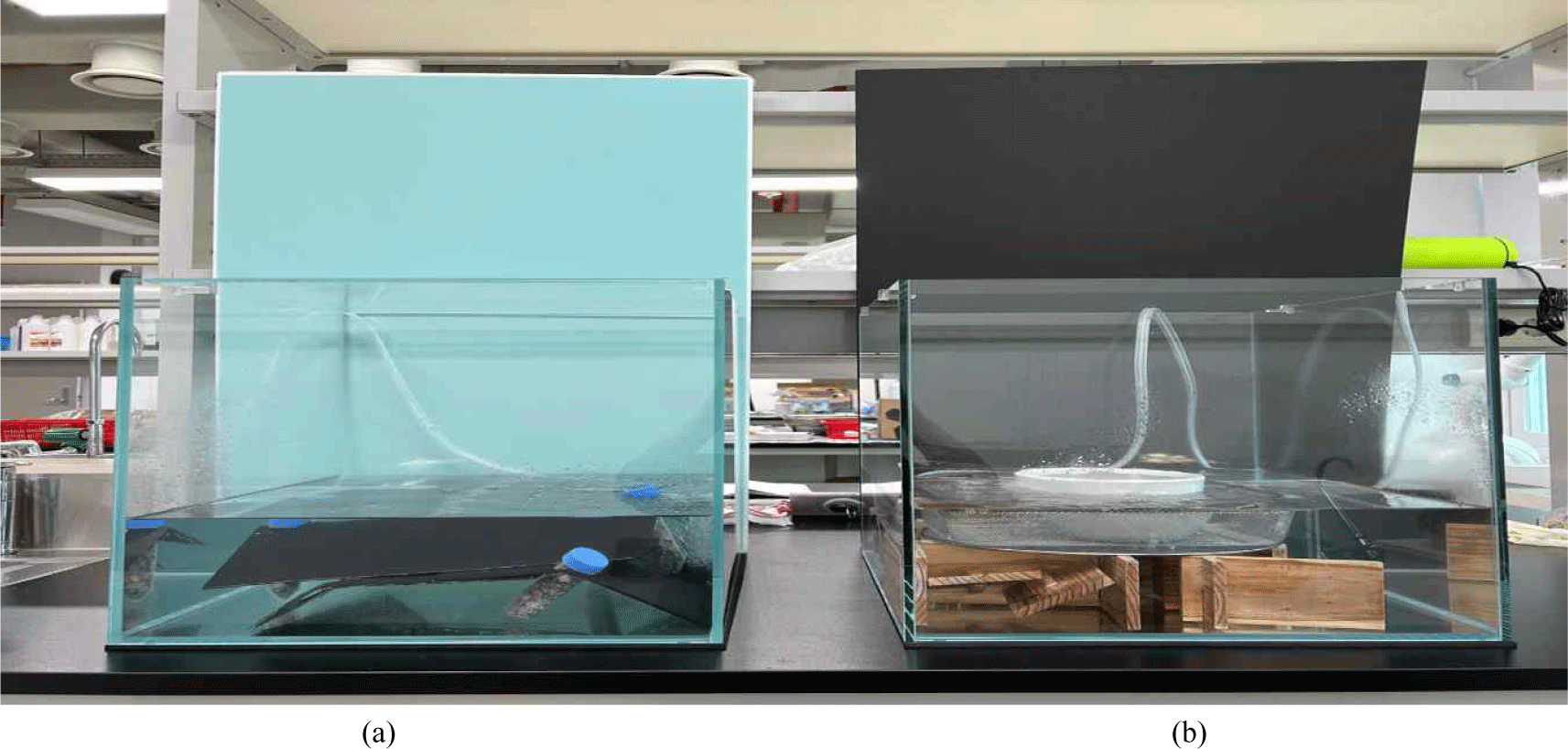
The sample was passed through a 20 μm stainless-steel sieve and the sieve was washed with high-performance liquid chromatography (HPLC)-grade water. The sieve was transferred to a 250 mL glass beaker and then placed in an oven at 60°C until the water evaporated. The sieve, placed in a 30% H2O2 solution-filled beaker, was agitated in an ultrasonic bath for 5 min to desorb organic matter. The content in the beaker was passed through the sieve to drain the mixed solution and the beaker was fully washed using HPLC-grade water. The solution was stirred on a hot plate (40°C, 180 rpm) for 2 hours and subsequently allowed to settle for 24 hours. After settling, the bottom layer of the solution, including settled particle, was drained. The supernatant layer, which included suspended particles, was filtered onto polycarbonate filter paper (5 μm, 47 mm Φ) using a vacuum pump. The filter paper was placed in a glass Petri dish and then dried in an oven at 40°C for 24 hours.
The filter paper was mounted on a holder and a random subsection on the surface of the filter paper was selected. The area was subdivided into 20 cells, and then each cell was observed with an optical microscope. Particles detected on the cells were examined to identify their type using a Fourier transform infrared (FT-IR) microscope (Nicolet iN10, Thermo Fisher Scientific, Waltham, MA, USA) in attenuated total reflectance mode. The spectrum was recorded through 16 scans in the spectral range of 4,000–500 cm–1 at a resolution of 4 cm–1. With regard to the analysis of the results, the infrared spectra of a particle were compared with the standard spectra of known polymers identified in spectral libraries to determine the chemical composition of the MPs.
Independent measures (between-groups) design was adopted as the experimental design for this study. Each wood species (JAC, MAP, OAK, HEM) was subjected to vacuum and pressure treatments with different durations (15/15 min, 30/30 min) and used as variables for analyzing the uptake and leachability of HCO. The uptake and leachability values were obtained from randomly selected wood specimens. Based on the analysis results, the HCO-treatment group was selected with a duration of 30/30 min to compare against untreated blocks as a control group. The impact of HCO treatment on dimensional stability, moisture tolerance, bending strength and Janka hardness was analyzed using the least significant difference test between HCO-treated and control groups. Values for the dimensional stability, moisture tolerance, bending strength, and Janke hardness were obtained from measurements of 12, 12, 6 and 6 wood strips per wood species, respectively. Analysis was carried out using the Minitab statistical analysis software package. A 95% confidence level was used in all statistical tests. The effect of the HCO treatment was examined using the General Linear Model procedure.
3. RESULTS and DISCUSSION
JAC (153.50%) blocks exhibited the highest HCO uptake, followed by HEM (73.80%), MAP (41.47%) and OAK (25.97%) blocks (p < 0.01). The disparity in HCO uptakes among wood species is likely due to their structural and anatomical differences. Particularly, density might have a significant impact on the HCO uptake. For example, JAC has the lowest density (0.30–0.42 g/cm3), followed by HEM (0.42–0.43 g/cm3), MAP (0.48–0.58 g/cm3), and OAK (0.87–0.89 g/cm3). Lower density is associated with higher HCO uptake (Anshari et al., 2011; DeBell et al., 2004; Hwang and Kim, 1999; Meier, 2022; Ogawa et al., 2022).
Fig. 4 depicts the effect of vacuum and pressure times on the HCO uptake of wood blocks. No significant differences were found between the HCO uptakes of JAC and OAK blocks treated with 30-min vacuum/ 30-min pressure (HCO-1) and 15-min vacuum/15-min pressure treatments (JAC: p = 0.98; OAK: p = 0.22). These results indicate that the 15-min vacuum and 15-min pressure treatments are sufficient for HCO to penetrate the cell wall of JAC. For OAK, vacuum and pressure treatments longer than 30 min are likely required for deep penetration of HCO into the cell wall due to its high density. The HCO uptakes of MAP and HEM blocks increased when the vacuum/pressure treatment was increased from 15/15 min to 30/30 min (HEM: p = 0.04; MAP: p < 0.01). The increase suggests that the penetration depth of HCO into the cell wall of HEM and MAP is affected by the duration of vacuum and pressure treatments, resulting in the measurable difference of HCO uptake.
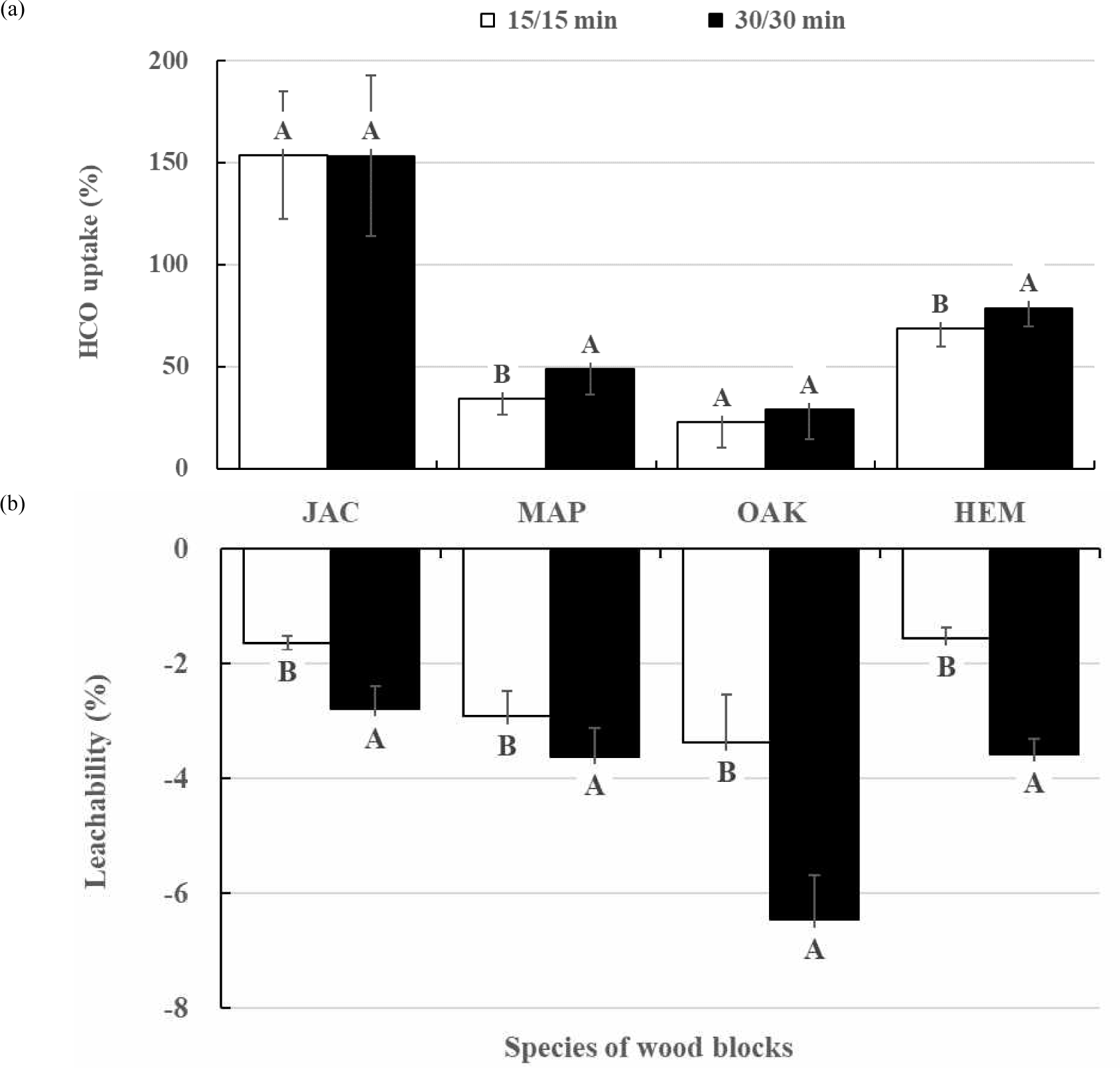
Weights of JAC, MAP, OAK and HEM control blocks immersed in saline water for 48 hours increased by 2.25%, 0.98%, 0.35% and 0.04%, respectively. The weight gains are most likely due to the solar salt retained on the surface layers of wood blocks after saline water leaching (Kwon et al., 2023a). Air- and oven-dried weights of HCO-treated JAC, MAP, OAK and HEM blocks also increased by 2.21%, 3.27%, 4.92% and 2.56% respectively, after leaching. The weight gains of HCO-treated MAP, OAK and HEM blocks were higher than those of the control blocks. The results are most likely attributed to the high moisture content in the wood blocks. Since the surface layer of the wood blocks is coated with HCO which has moisture-repellent properties, less moisture seemed to evaporate from HCO-treated blocks than from control blocks during the drying process, which contributed to their higher weight gains. For JAC, the weight gain of control blocks was higher than that of HCO-treated blocks, likely due to the higher HCO uptake of HCO-treated JAC blocks compared to other wood species. This may explain the extra HCO that was present on the surface layers (Kwon et al., 2023a).
Fig. 4 illustrates the effect of vacuum and pressure times, which were used for treating HCO, on the leachability of wood blocks. The leachability of HCO-treated blocks decreased with the increase in the duration of vacuum and pressure treatments (p < 0.01). These results indicate that the penetration depth of HCO into the cell wall is affected by the length of vacuum and pressure treatments, resulting in the differences in leaching resistance.
The X-ray microscopic images show that HCO was able to penetrate uniformly to inner parts of JAC and HEM strips, while the penetration was relatively limited to the surface of MAP and OAK strips, likely due to its higher density compared to other strips (Fig. 5). HCO was observed to remain in all strips after leaching. The results indicate that HCO may have a role in preventing moisture absorption from the strips. These findings are consistent with previous studies that have demonstrated the benefits of reducing hydroxyl groups in holocellulose for improving biological resistance and reducing the equilibrium moisture content of wood (Nawawi et al., 2023; Nuopponen, 2005). The results suggest that HCO may have potential as a moisture repellent for wood products.
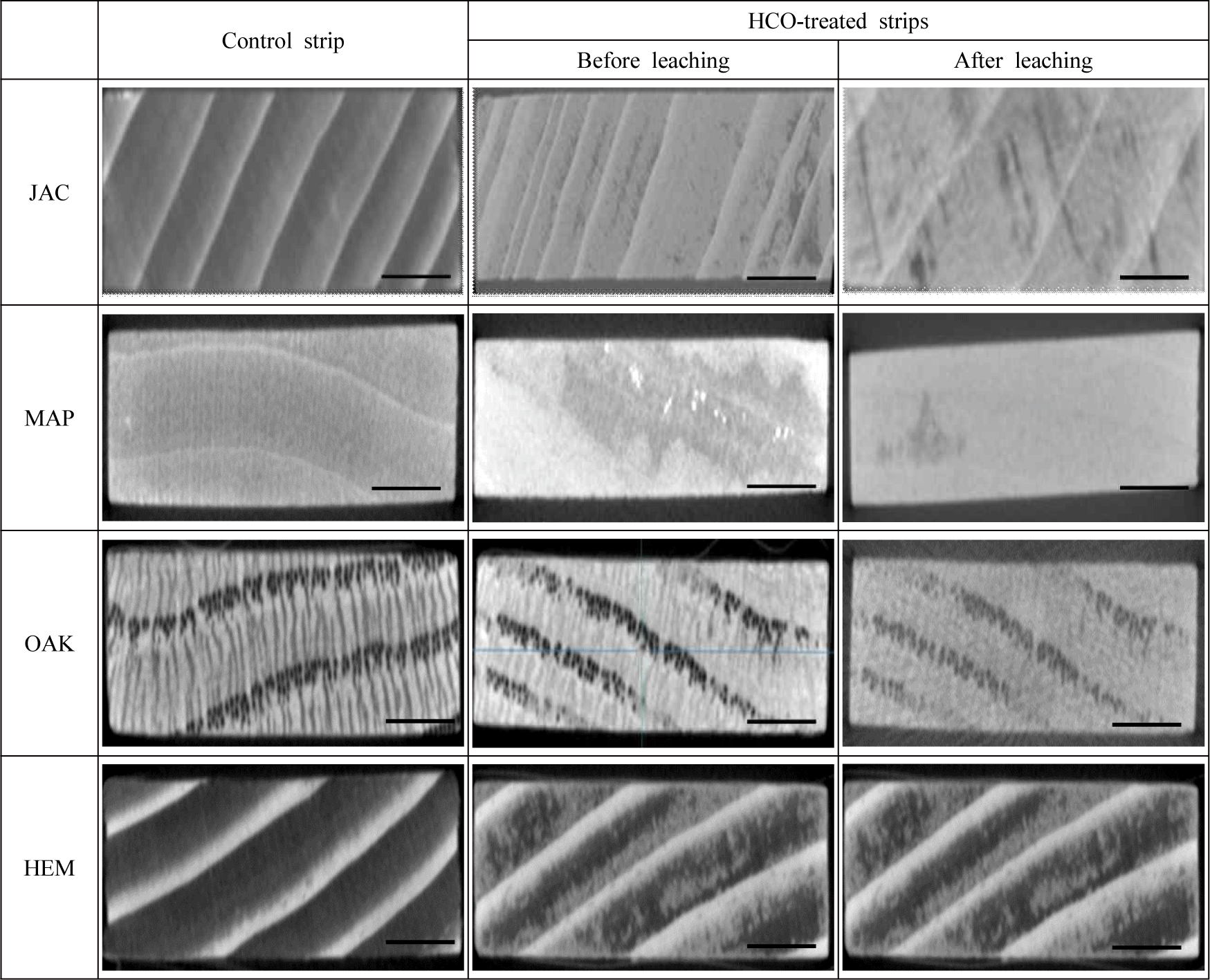
The results of TVS, calculated by adding the length, width and thickness swellings, of control and HCO-1-treated wood strips immersed in saline water for 2 weeks are presented in Fig. 6. The TVSs of HCO-1-treated JAC (p < 0.01), MAP (p = 0.03) and HEM (p = 0.03) were significantly lower than those of control strips. The lower TVS values suggest that HCO may penetrate effectively into the cell wall of JAC, MAP and HEM, thereby restraining the swelling of the wood strips against saline water leaching compared to the control strips. However, the TVS value of HCO-1-treated OAK strips did not differ significantly from that of control strips (p = 0.06). The result can be attributed to the lower HCO uptake of OAK compared to JAC, MAP and HEM (Fig. 4). Therefore, the adequate penetration of HCO into the cell wall of wood is expected to contribute to improving its dimensional stability against saline water leaching.
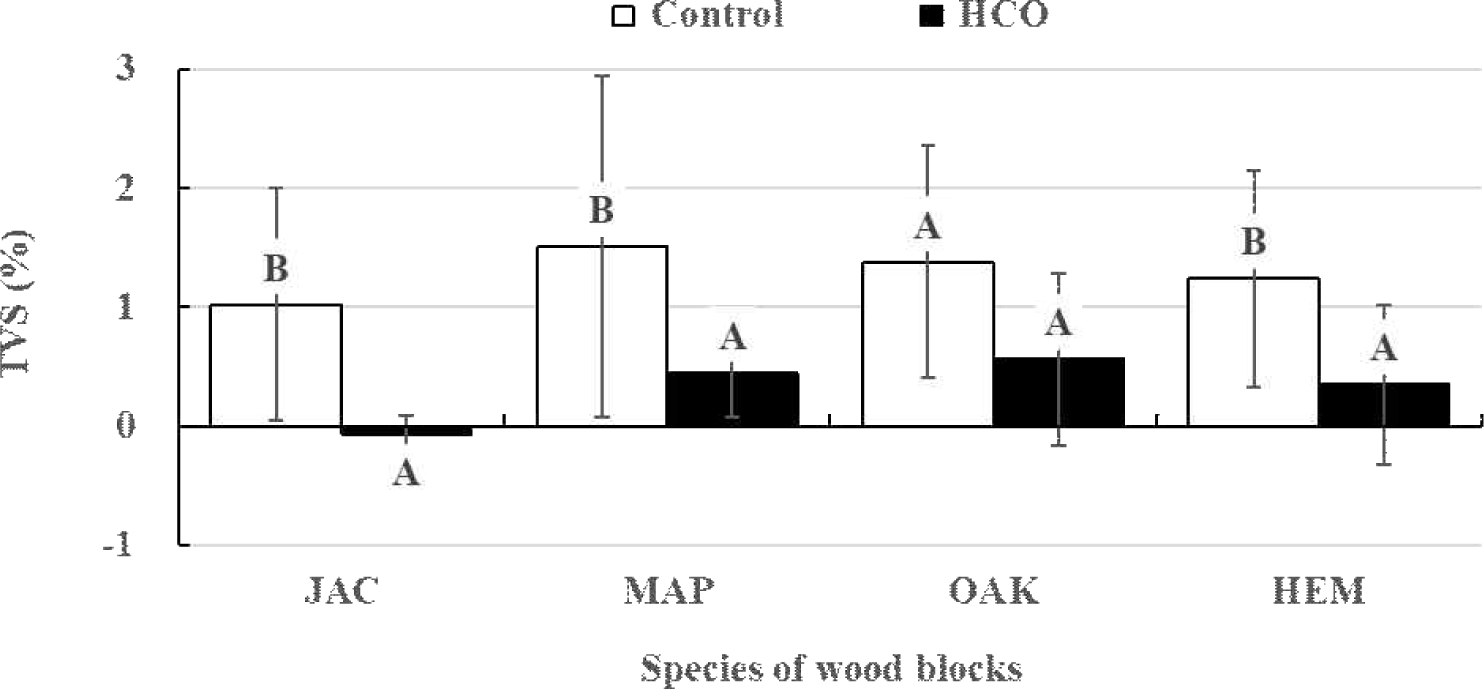
Fig. 7 presents the results of the MA and TVS tests of control and HCO-1-treated wood strips exposed outdoors for 2 weeks. The weight gains of HCO-1-treated wood strips were significantly lower than those of control strips (p < 0.01). In addition, regardless of wood species, TVS values of HCO-1-treated wood strips were significantly lower than those of control strips (p < 0.01). The lower MA and TVS values are most likely due to the sufficient penetration of HCO into the cell wall of the strips. HCO, penetrated adequately using a vacuum-pressure treatment, covers the hydroxyl groups existing in the wood strips, and therefore may improve moisture-repellent effectiveness and dimensional stability.

Table 2 presents the bending strength and Janka hardness of wood strips, treated with HCO and subsequently immersed in saline water for 2 weeks. No significant differences between the bending strengths of control and HCO-1-treated MAP (p = 0.27), OAK (p = 0.23) and HEM (p = 0.27) strips were found. However, the bending strength of JAC strips increased with the treatment of HCO (p < 0.01). The increase is presumably due to the effective penetration of HCO into the cell wall (Kwon et al., 2023a). Therefore, it is thought that the treatment of HCO using a vacuum-pressure treatment can be a way to increase the bending strength of low-density species like JAC.
Janka hardness of JAC (p < 0.01), MAP (p < 0.01), OAK (p = 0.03) and HEM (p < 0.01) strips significantly increased with the treatment of HCO (Table 2). The results suggest that HCO treatment of wood affects the hardness of wood positively.
The detection and quantification of MPs were successfully conducted by the analyzing method used in this study (Fig. 8). The main MPs observed in tap water and solar salt, which were used for the formulation of saline water, were polyethylene (PE), PP, polyesters, such as PET and polybutylene terephthalate, and in smaller amounts, ethylene vinyl acetate (EVA), as depicted in Table 3. The quantity of MPs detected in saline water samples was affected by the type of shelters. A lower number of MPs was found in the wooden shelters-immersed saline water sample than in the plastic shelters-immersed saline water sample, regardless of the immersion period as expected. These results are a potential indication of plastic debris originating from the plastic shelters during the immersion process. Except for the main polymers present in the tap water and solar salt, polyurethane (PU) was detected in both saline water samples. The presence of PU could likely have come from a PU used as a waterproof sealant in the glass aquariums.
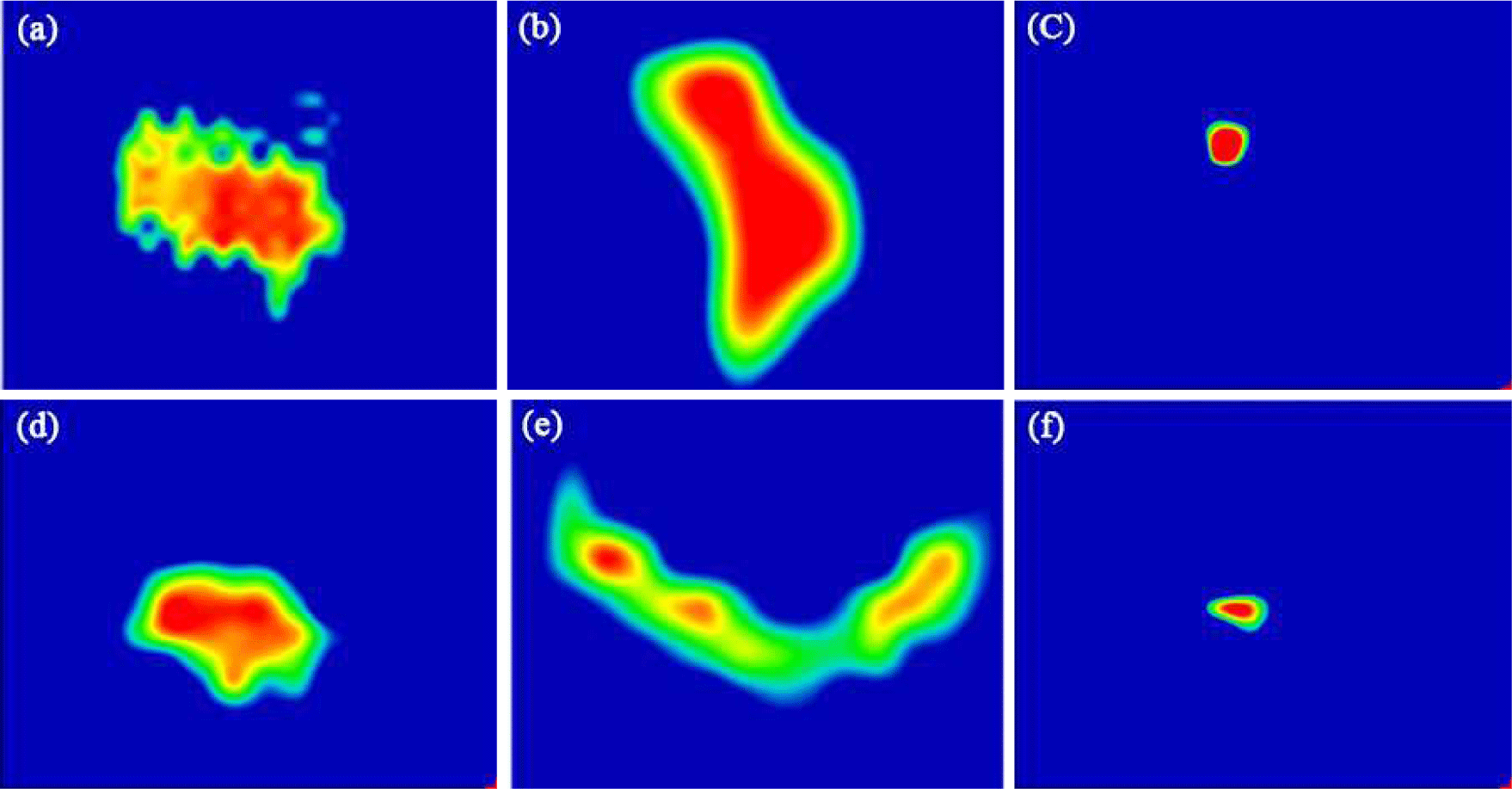
With regard to the results based on the immersion period, a higher number of MPs was found in the saline water samples in which the plastic shelter was immersed in for 6 weeks than for 2 and 4 weeks (Table 3). Contrary to the plastic shelter-immersed saline water samples, the number of MPs detected in wooden shelter-immersed saline water samples remained steadily for 6 weeks. These results indicate that the plastic shelters contribute to MP contamination of the saline water and the number of MPs generated from the shelter tends to increase with the lengthening of the immersion period. However, further studies are required to clearly identify the generating source of MPs detected in the saline water samples since the solar salt contained many PE, PP and polyester particles.
4. CONCLUSIONS
HCO uptake of JAC was much higher than that of HEM, MAP and OAK. The weight gains of HCO-treated specimens were higher than those of control specimens after saline water leaching, due to the solar salt retained onto the surface layers of wood blocks. TVS values of the HCO-treated specimens were less than 1%. MA and TVS values of the HCO-treated specimens after outdoor exposure were much lower than those of control specimens regardless of wood species. HCO treatment provided the improvement of Janka hardness of all wood strips although the significant increase of bending strength was found only in JAC, which has the lowest density among the strips tested in this study. The number of MPs detected in the saline water samples immersed by shelters fabricated with HCO-treated JAC was lower than that by plastic shelters. The quantity of MPs detected in the wooden shelter-immersed saline water samples was not affected by the period of immersion. Contrary to the wooden shelters, the higher number of MPs was detected in the saline water samples that plastic shelter was immersed for 6 weeks than for 2 and 4 weeks. Overall, it is thought that HCO-impregnated wood, particularly JAC, can be an environmentally friendly material to plastics to fabricate shelters. The onsite application of wooden shelters is expected to mitigate MP-related pollutions in areas of abalone aquaculture although further researches should be conducted considering will be needed to identify the resistance of HCO-treated woods against repeated impacts of planks, sand, ice, and other solid pieces carried by waves, wind, and tides as well as decomposition of wood-degrading organisms such as bacteria, decay fungi, and marine borers.









